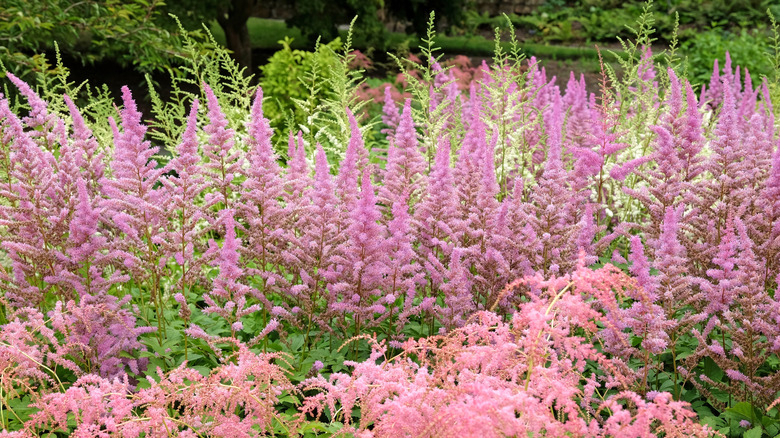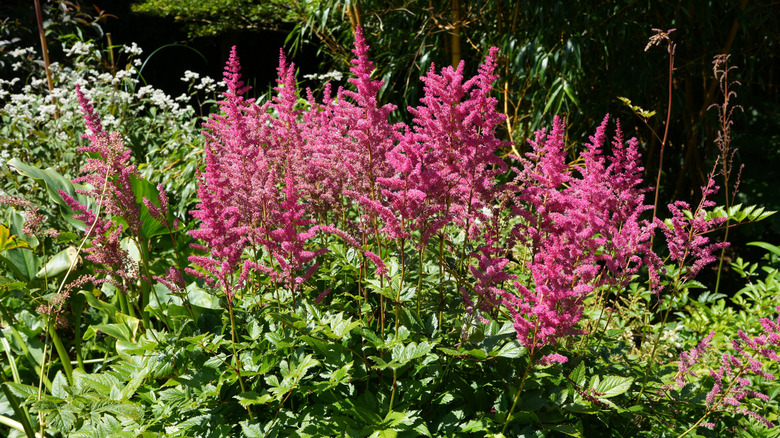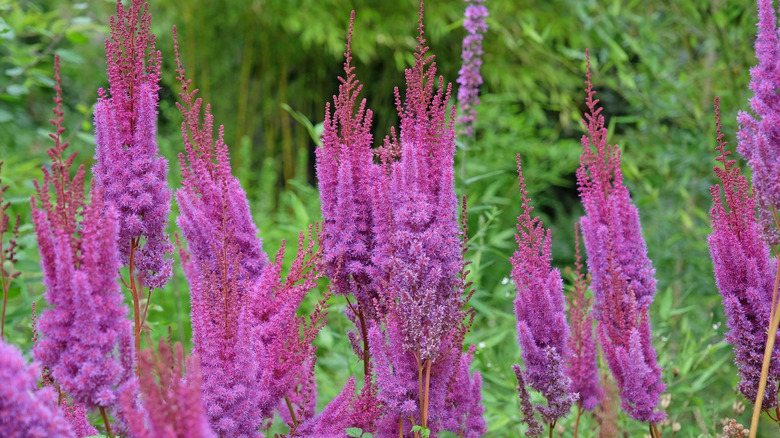Why Your Astilbes Aren't Flourishing, And Tips To Help Them Thrive, From Our Professional Gardener
Astilbes are showy flowering perennials that produce fluffy plumes covered in colorful tiny flowers in shades of pink, red, white, and purple. Thriving in partial sun to full shade, these are generally a long-lived and low-maintenance perennial. But they have specific conditions they prefer to be grown in, so if your astilbes aren't flourishing, there are some tips for helping them to achieve more vibrant growth and health.
These shade-loving beauties are such a boon to the shade garden, adding much needed color and delicate texture next to sturdy green hostas. Depending on the variety, they start blooming in early June, with some continuing to flower into August. They will also tolerate a fair amount of sun, though morning sun is preferable to afternoon sun. It's fairly easy to tell if your astilbes are getting too much sun: the leaves will look a bit droopy and might even turn brown or crispy during extreme heat. If you get hot summer weather, growing your astilbes in shade is your best bet.
Once you've chosen a good location for your astilbes that won't be too hot or sunny in summer, you'll also want to determine if the soil conditions are right for growing astilbes. Adjusting sun or shade conditions isn't exactly straightforward or maybe not even possible in some cases. Fortunately, you can amend store-bought soil to improve the life of your astilbes, as there are some specific soil needs these perennials prefer to keep them in top form.
Proper soil conditions are key
Astilbes are a gorgeous addition to a shade garden, brightening dark corners with delicate and vivid colors. Think of them as sturdy but dainty goddesses of the shade bed. But you don't have to worship them: just give them proper soil conditions! Astilbes prefer a rich, moist, well-drained soil that is slightly acidic. Because they form thick, somewhat matted root clumps, good soil drainage is crucial to help them get enough moisture. Clay soil is not a good environment for them, so if you have mostly clay soil, you'll need to add amendments before planting.
When planting astilbes, which is best done in spring or fall, space them 18 to 24 inches apart. Dig a hole larger than the plant so you can include plenty of suitable soil around it. A good loamy organic garden soil with compost, peat moss, and some used coffee grounds is recommended. Place a layer of this soil mix in the hole, and make sure there is plenty to surround your astilbe plant. Water it well (once a day) in the first week or two to help it get established.
It's also good to choose a planting location where your astilbes will get rain: some trees have heavy leaf canopies that block rain and this ends up in what we call a "dry shade" environment. Some shade plants do okay with this, but astilbes like to get rained on. If you experience a long period without rain or a heat wave, be sure your astilbes get watered regularly. Too much water should be avoided, though, and avoid planting them in boggy areas that stay consistently wet.
Other tips for thriving astilbes
Okay, so you added good soil amendments to improve drainage and soil texture, and you're watering your astilbes regularly, but they're still not flowering like gangbusters? You may not be doing anything wrong. It can take astilbes several years to get established, especially if you're growing from a bare root cutting or division. Once your astilbe is at least 8 to 10 inches in diameter at the base, you should start to see more vigorous flowering, so be patient and you will soon have gorgeous summer blooms lasting weeks in the garden.
Astilbes can grow quite large, and these large clumps really look great when flowering. But they also need dividing so they don't get too big. Also, the rounded clumps tend to spread a bit sideways if they aren't divided regularly. You should divide your mature astilbes every three years or so. You may find when dividing them that small root divisions (which are actually rhizomes) become detached. Don't worry about this too much, just plant them where you want more, or give the divisions to friends.
Some gardeners have good luck fertilizing their astilbes to encourage more vigorous blooms. Use a basic slow release plant fertilizer like Espoma Plant-Tone, and apply according to package directions in spring just after new growth appears. You can also feed your astilbe by spreading a light layer of compost at the base of the plant in spring: this slowly distributes helpful nutrients. You can use this same method with aged manure in the fall, which provides a good slow feed over the winter.


